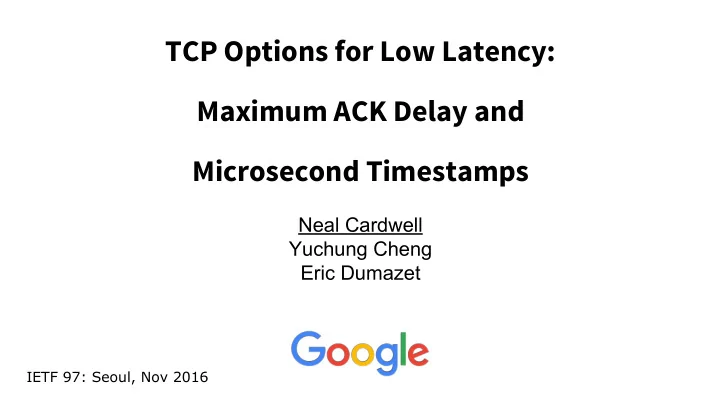

TCP Options for Low Latency: Maximum ACK Delay and Microsecond Timestamps Neal Cardwell Yuchung Cheng Eric Dumazet IETF 97: Seoul, Nov 2016
Motivation: lower latency, higher throughput Datacenters with commodity 10Gbps Ethernet: RTT <100 us Outdated fixed parameters: TCP Timestamps: granularity is 1 ms .. 1 sec [ 10x RTT ] Delayed ACKs: typical delays: 40 ms .. 200 ms [ 400x RTT ] RFC minimum RTO of 1 sec [ 10,000x RTT ] Goal: negotiate of values to fit today's networks Open-source Google's Linux TCP code for these Standardize option format and semantics in IETF 2
Minimum RTO Most TCPs have min RTO of 200 ms .. 1 sec; why? Delayed ACKs: typical delays: 40 ms .. 200 ms [ 400x RTT ] RFC minimum RTO of 1 sec [ 10,000x RTT ] But switches don't have 1 s. of buffer; hosts don't delay ACKs by 1 s. Google experience, incast research [1] [2] [3]: lower timeouts help app latency Quicker RTO, TLP: simple way to vastly reduce latency ~40x (200ms -> 5ms) Google uses 5ms internally since 2013 ([3] mentions 5ms as well) 3
Maximum ACK Delay (MAD) But if RTO is fast even when ACKs are delayed: -> spurious retransmits and congestion control back-off How to know long ACKs may be delayed? Negotiate Max ACK Delay (MAD) in an option in TCP handshake... Small MAD negotiated => enables small min RTO => improves performance 4
Microsecond TCP Timestamps: Motivation TCP Timestamps [RFC1323][RFC7323]: finest allowed granularity is 1 ms But RTTs are < 100 us and soon 10 us in the datacenter Benefits of 1 us TCP timestamps: Can undo cwnd reductions in datacenter In datacenter, original and fast retransmit have same 1ms timestamp Can't use TCP timestamps to undo cwnd reduction [RFC3522/RFC4015] Can do fine-grained measurement and diagnostics One-way delay variation for data (e.g. incast queues), ACKs 5
Microsecond TCP Timestamps: Implementation When using usec TS, need to adjust a constant in PAWS logic When to expect 32-bit wrap-around in idle connections [RFC7323 sec 5.5]: 1 ms => wraps in ~24 days 1 us => wraps in ~34 minutes 1 ns => wraps in ~2 secs How? Negotiate use in an option in TCP handshake... Handles the general/cloud/SaaS case (Could also use per-route config if this is intradomain traffic) 6
Options and the TCP Handshake SYN <MAD 10ms usTS,...> Remote MAD = 10ms usTS = on SYN + ACK <MAD 5ms usTS,...> ACK Remote MAD = 5ms usTS = on 7
Max ACK Delay and Min RTO interaction RTO = f1(RTT) + f2(RTTVAR) + MAD Data Delayed ACK Delayed ACK < MAD 8
Low Latency Option: Proposed Format 0 1 2 3 0 1 2 3 4 5 6 7 8 9 0 1 2 3 4 5 6 7 8 9 0 1 2 3 4 5 6 7 8 9 0 1 +-+-+-+-+-+-+-+-+-+-+-+-+-+-+-+-+-+-+-+-+-+-+-+-+-+-+-+-+-+-+-+-+ | Kind | Length | RFC 6994 ExperimentID | +-+-+-+-+-+-+-+-+-+-+-+-+-+-+-+-+-+-+-+-+-+-+-+-+-+-+-+-+-+-+-+-+ |u|M u| MAD | | |s|A n| Value | Res | ... |T|D i| (10 bits) | | |S| t| | | +-+-+-+-+-+-+-+-+-+-+-+-+-+-+-+-+-+-+-+-+-+-+-+-+-+-+-+-+-+-+-+-+ usTS: use microsecond timestamps? (0 = no usec Timestamps; 1 = usec Timestamps) MAD unit: time units for MAD value (0 = no MAD negotiated; 1=msecs, 2=usecs, 3=nsecs) MAD value: Maximum ACK Delay value (1 ... 999) Total space: 6 bytes - using 2-byte RFC 6994 ExperimentID 4 bytes - if promoted to standard with its own option Kind (no ExperimentID) 9
Status Code for these 2 features has matured at Google (used for all internal TCP traffic) ● Maximum ACK Delay: since Jul 2005 (yes, 11 years ago!) ● Microsecond timestamps: since Feb 2015 (1.75 years ago) Verbal interest from at least one other major TCP implementor for MAD Next steps: 1. Internet Draft 2. Change code to support RFC6994 experimental option format 3. Send code upstream to Linux by Q1 2017 10
Recommend
More recommend